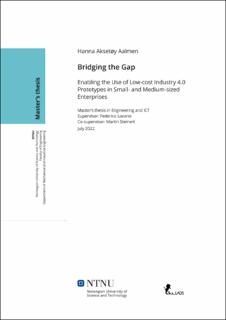| dc.contributor.advisor | Lozano, Federico | |
| dc.contributor.advisor | Steinert, Martin | |
| dc.contributor.author | Aalmen, Hanna Aksetøy | |
| dc.date.accessioned | 2022-09-10T17:19:50Z | |
| dc.date.available | 2022-09-10T17:19:50Z | |
| dc.date.issued | 2022 | |
| dc.identifier | no.ntnu:inspera:114172731:26300790 | |
| dc.identifier.uri | https://hdl.handle.net/11250/3017028 | |
| dc.description.abstract | Denne Masteroppgaven omhandler arbeidet som er blitt gjort i forbindelse med utviklingen og implementasjonen av lavkostnads Industri 4.0-prototyper i små og mellomstore bedrifter. Prosjektet har blitt delt i to seksjoner som har blitt utviklet parallelt. Den første seksjonen omhandler utviklingen av et sensorsett som er i stand til å generere data om produksjonen av et trevareprodukt ved overvåkning av verktøy som inngår i prosessen. Den andre seksjonen omhandler utviklingen av brukervennlig programvare som både kan være et læremiddel for brukeren i å sette opp de aktuelle sensorprototypene, samt at det også viser avlesninger fra sensorene til brukeren i sanntid.
Denne oppgaven forsøker å svare på tre forskningsspørsmål gjennom prototyping og programvareutvikling. Spørsmålene lyder som følger:
1) Kan data fra lavkostnads Industri 4.0-løsninger nøyaktig vise hvilke prosesser som skjer på en produksjonsbenk for treverk?
2) Er en produksjonsleder med minimal erfaring innen IoT i stand til å sette opp og tolke data fra en Arduino når han eller hun får instruksjoner og ferdig kode?
3) Kan et lavkostnads Industri 4.0-system generere verdifull data for en trevarebedrift der de fleste prosesser er manuelle?
Resultatene fra prototypingen er lovende, og har ført til verdifull innsikt som videre kan bidra til forbedringer av det foreslåtte systemet. | |
| dc.description.abstract | This Master's Thesis describes the work that has been done in order to develop and implement low-cost Industry 4.0 conceptual prototypes in a small- and medium-sized enterprise. The project has been divided into two main branches which have been worked on in parallel. The first branch concerns the development of sensors which track the assembly of a wooden product by monitoring the tools used in the process. The second branch concerns the development of a user friendly and easy-to-understand software which is capable of both teaching the user to set up the system of sensors on their own, while also serving as an interface which shows the readings from the sensor prototypes in real time.
This thesis attempts to answer three research questions through sensor protoyping in parallel with a software development process. The following three research questions are addressed:
1) Can data from low-cost Industry 4.0 solutions accurately represent the activity conducted at a wood product assembly station?
2) Is a production manager with minimal experience with IoT able to set up an Arduino and interpret its data when provided instructions and pre-written code?
3) Does a low-cost Industry 4.0 system generate valuable data for a wood product manufacturer where most processes are done manually?
The results from the prototyping activities conducted are promising and have resulted in valuable insight for further improvement of the proposed system. | |
| dc.language | eng | |
| dc.publisher | NTNU | |
| dc.title | Bridging the Gap - Enabling the Use of Low-cost Industry 4.0 Prototypes in Small- and Medium-sized Enterprises | |
| dc.type | Master thesis | |
